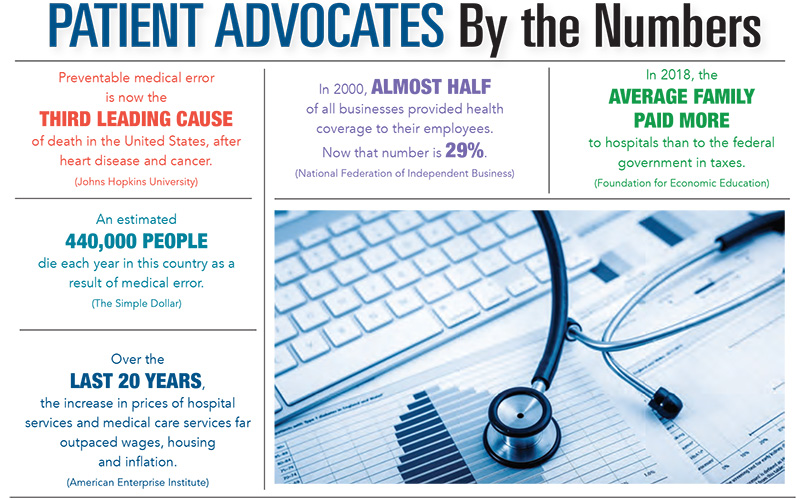Navigating the health care system as a patient is overwhelming, so much so that many people avoid appointments altogether due to uncertainty about getting bogged down in the details of insurance, follow-up appointments and a myriad of other complexities.
Just the mention of scheduling a doctor’s appointment is sure to induce a spike in blood pressure and a feeling of anxiety for a lot of people.
“I hear this over and over from patients: ‘I didn’t realize how easy working with a patient advocate was,’” said Julia Pinckney, CEO of AmbassaCare, an organization on a mission to transform the patient experience by standing with patients as they navigate the complex waters of the health care system. “Unfortunately, most people are unaware that a service like this exists, and those that do know about us are often hesitant to reach out due to worries this may somehow offend their doctor.”
The role of a patient care advocate and nurse navigator is becoming increasingly common, however, and even more important as advancements in medicine and quality of care outpace advancements in the health care system itself.
A patient advocate operates on behalf of patients, helping them make appointments, follow-ups and understanding insurance obstacles – essentially any touchpoint that can take the burden off the patient and increase their quality of care.
It’s a common mistake to think patient advocates are primarily used by the elderly, who are more likely to fall victim to systemic challenges. In reality, the average age of someone who uses a patient advocate is closer to 32. People of all ages are subject to the challenges of the health care system, and organizations like AmbassaCare are making life easier for patients across the board.
“The main thing I want to impress upon patients is that if they take ownership of their experience and realize we are here to guide them, they will see that the limitations of the health care system are not the same as exclusions,” said Pinckney. “We’re looking to impact the process in those critical moments. For a lot of people, a $10,000 deductible may as well be a $100,000 deductible. But if they connect with us before they go for expensive imaging, for example, we can negotiate on their behalf and save them a lot of money.”
Saving money is just one of the possibilities when working with a patient care advocate. There are many situations where having an advocate saves lives.
“We had one client who needed to be evaluated by four specialists in a very short period of time. They were so incredibly overwhelmed by the potential diagnosis that they weren’t able to get an appointment. We used resources on the insurance and clinical side to coordinate care at the time it was needed, literally saving their life. We often hear things from patients like, ‘I was told there wasn’t an appointment available until September’ – and they just accept that as truth. In this case, had we not deployed our resources to get an immediate appointment, the outcome would have been fatal.”
This seems to be a systemic issue, one that creates challenges for doctors as well as patients. There is a limited amount of care available, and, if patients don’t have someone taking the extra steps to advocate for them, they can unfortunately fall victim to the inadequacies of the health care system.
“Some patients won’t seek the services of a patient advocate for fear of what the doctor will think. I’ll tell you that most doctors are thrilled to have someone there to act as a connection point. Once I had a doctor pull me to the side after an appointment with one of our clients and ask me, ‘Is this what I can expect every time I work with your company?’ and I said, ‘Yes, it is.’ To which he replied, ‘Great, I look forward to working with you in the future,’” Pinckney shared.
Just as there are endless variables in dealing with the health care system, there are endless ways that a nurse navigator or patient advocate can operate within the system to help patients.
At Health Related Home Care, with locations in Abbeville and Greenwood, they also act as a bridge between the patient and the doctor.
“Typically, we are keeping tabs on patients in the home, and, if they are hospitalized, our care transition navigator will go check on them when they are ready to return home to ensure they are set up for the services needed,” said Leslie Taylor, clinical manager at HRHC. “For example, one of the services we offer is respiratory therapy, so, if Mr. Smith is coming home and he was in the hospital with respiratory failure, we’ll handle any connections that need to be made so he can focus on recovery.”
The role of a care transition navigator lies somewhere in between a patient advocate and an outreach coordinator, keeping an eye on those in the community who may need someone to step in and handle the things they aren’t equipped to handle.
“Our care transition navigators report to branch directors, and they find patients who will benefit from our services by going to doctors’ offices, sharing our successes, asking doctors if they have patients who are noncompliant or in and out of hospitals. Not all agencies do that, but we are at the front line, face-to-face with patients so they know and trust that we are going to make sure they get the best care available to them,” she said.
By James Crawford

